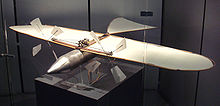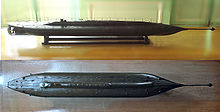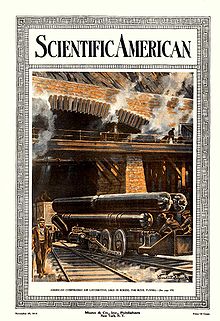- Compressed-air vehicle
-
 The Victor Tatin airplane of 1879 used a compressed-air engine for propulsion. Original craft, at Musée de l'Air et de l'Espace.
The Victor Tatin airplane of 1879 used a compressed-air engine for propulsion. Original craft, at Musée de l'Air et de l'Espace.
 The first mechanically powered submarine, the 1863 Plongeur, used a compressed-air engine. Musée de la Marine (Rochefort).
The first mechanically powered submarine, the 1863 Plongeur, used a compressed-air engine. Musée de la Marine (Rochefort).
A compressed-air vehicle (CAV) is powered by an air engine, using compressed air, which is stored in a tank. Instead of mixing fuel with air and burning it in the engine to drive pistons with hot expanding gases, compressed-air vehicles use the expansion of compressed air to drive their pistons. One manufacturer claims to have designed an engine that is 90 percent efficient.[1]
Compressed-air propulsion may also be incorporated in hybrid systems, e.g., battery electric propulsion and fuel tanks to recharge the batteries. This kind of system is called a hybrid-pneumatic electric propulsion. Additionally, regenerative braking can also be used in conjunction with this system.
Contents
Technology
Engine
Main article: Compressed air engineOne can buy the vehicle with the engine or buy an engine to be installed in the vehicle. Typical air engines use one or more expander pistons or rotary expander like the Quasiturbine. In some applications it is advantageous to heat the air, or the engine, to increase the range or power.
Tanks
Main article: Compressed air tankThe tanks must be designed to safety standards appropriate for a pressure vessel, such as ISO 11439.[2]
The storage tank may be made of:
- steel,
- aluminium,
- carbon fiber,
- Kevlar,
- other materials, or combinations of the above.
The fiber materials are considerably lighter than metals but generally more expensive. Metal tanks can withstand a large number of pressure cycles, but must be checked for corrosion periodically.
One company stores air in tanks at 4,500 pounds per square inch (about 30 MPa) and hold nearly 3,200 cubic feet (around 90 cubic metres) of air.[3]
The tanks may be refilled at a service station equipped with heat exchangers, or in a few hours at home or in parking lots, plugging the car into the electrical grid via an on-board compressor. The cost of driving such a car is typically projected to be around €0.75 per 100 km, with a complete refill at the "tank-station" at about US$3.
Compressed air
Main article: Compressed airCompressed air has a low energy density. In 300 bar containers, about 0.1 MJ/L and 0.1 MJ/kg is achievable, comparable to the values of electrochemical lead-acid batteries. While batteries can somewhat maintain their voltage throughout their discharge and chemical fuel tanks provide the same power densities from the first to the last litre, the pressure of compressed air tanks falls as air is drawn off. A consumer-automobile of conventional size and shape typically consumes 0.3-0.5 kWh (1.1-1.8 MJ) at the drive shaft[4] per mile of use, though unconventional sizes may perform with significantly less.
Emission output
Like other non-combustion energy storage technologies, an air vehicle displaces the emission source from the vehicle's tail pipe to the central electrical generating plant. Where emissions-free sources are available, net production of pollutants can be reduced. Emission control measures at a central generating plant may be more effective and less costly than treating the emissions of widely dispersed vehicles.
Since the compressed air is filtered to protect the compressor machinery, the air discharged has less suspended dust in it, though there may be carry-over of lubricants used in the engine.
History
 Gotthardbahn: Pneumatic Locomotive with attached pressure container.[5]
Gotthardbahn: Pneumatic Locomotive with attached pressure container.[5]
Compressed air has been used since the 19th century to power mine locomotives and trams in cities such as Paris (via a central, city-level, compressed air energy distribution system), and was previously the basis of naval torpedo propulsion.
During the construction of the Gotthardbahn from 1872 to 1882, pneumatic locomotives were used in the construction of the Gotthard Rail Tunnel and other tunnels of the Gotthardbahn.
In 1903, the Liquid Air Company located in London England manufactured a number of compressed-air and liquified-air cars. The major problem with these cars and all compressed-air cars is the lack of torque produced by the "engines" and the cost of compressing the air.[6]
Recently several companies have started to develop compressed air cars, although none have been released to the public, or have been tested by third parties.
Advantages
Compressed-air vehicles are comparable in many ways to electric vehicles, but use compressed air to store the energy instead of batteries. Their potential advantages over other vehicles include:
- Much like electrical vehicles, air powered vehicles would ultimately be powered through the electrical grid. Which makes it easier to focus on reducing pollution from one source, as opposed to the millions of vehicles on the road.[citation needed]
- Transportation of the fuel would not be required due to drawing power off the electrical grid. This presents significant cost benefits. Pollution created during fuel transportation would be eliminated.[citation needed]
- Compressed-air technology reduces the cost of vehicle production by about 20%, because there is no need to build a cooling system, fuel tank, Ignition Systems or silencers.[7]
- Air, on its own, is non-flammable.
- The engine can be massively reduced in size.[8]
- The engine runs on cold or warm air, so can be made of lower strength light weight material such as aluminium, plastic, low friction teflon or a combination.[citation needed]
- Low manufacture and maintenance costs as well as easy maintenance.[citation needed]
- Compressed-air tanks can be disposed of or recycled with less pollution than batteries.[citation needed]
- Compressed-air vehicles are unconstrained by the degradation problems associated with current battery systems.[3]
- The air tank may be refilled more often and in less time than batteries can be recharged, with re-filling rates comparable to liquid fuels.[citation needed]
- Lighter vehicles cause less damage to roads, resulting in lower maintenance cost.
- The price of filling air powered vehicles is significantly cheaper than petrol, diesel or biofuel. If electricity is cheap, then compressing air will also be relatively cheap.[citation needed]
Disadvantages
Like the modern car and most household appliances, the principal disadvantage is the indirect use of energy. Energy is used to compress air, which - in turn - provides the energy to run the motor. Any conversion of energy between forms results in loss. For conventional combustion motor cars, the energy is lost when oil is converted to usable fuel - including drilling, refinement, labor, storage, eventually transportation to the end-user. For compressed-air cars, energy is lost when electrical energy is converted to compressed air.
- When air expands, as it would in the engine, it cools dramatically (Charles's law) and must be heated to ambient temperature using a heat exchanger similar to the Intercooler used for internal combustion engines. The heating is necessary in order to obtain a significant fraction of the theoretical energy output. The heat exchanger can be problematic. While it performs a similar task to the Intercooler, the temperature difference between the incoming air and the working gas is smaller. In heating the stored air, the device gets very cold and may ice up in cool, moist climates.
- Refueling the compressed-air container using a home or low-end conventional air compressor may take as long as 4 hours though the specialized equipment at service stations may fill the tanks in only 3 minutes.[citation needed]
- Tanks get very hot when filled rapidly. SCUBA tanks are sometimes immersed in water to cool them down when they are being filled. That would not be possible with tanks in a car and thus it would either take a long time to fill the tanks, or they would have to take less than a full charge, since heat drives up the pressure.
- Early tests have demonstrated the limited storage capacity of the tanks; the only published test of a vehicle running on compressed air alone was limited to a range of 7.22 km (4 mi).[9]
- A 2005 study demonstrated that cars running on lithium-ion batteries out-perform both compressed-air and fuel cell vehicles more than threefold at same speeds.[10] MDI has recently claimed that an air car will be able to travel 140 km (87 mi) in urban driving, and have a range of 80 km (50 mi) with a top speed of 110 km/h (68 mph) on highways,[11] when operating on compressed air alone.
Possible improvements
- Compressed-air vehicles operate to a thermodynamic process as air cools down when expanding and heats up when being compressed. As it is not possible in practice to use a theoretically ideal process, losses occur and improvements may involve reducing these, e.g., by using large heat exchangers in order to use heat from the ambient air and at the same time provide air cooling in the passenger compartment. At the other end, the heat produced during compression can be stored in water systems, physical or chemical systems and reused later.
- It may be possible to store compressed air at lower pressure using an absorption material within the tank. Absorption materials such as Activated carbon,[12] or a metal organic framework[13] is used to store compressed natural gas at 500 psi instead of 4500 psi, which amounts to a large energy saving.
Vehicles
Trikes
Three mechanical engineering students from San Jose State University; Daniel Mekis, Dennis Schaaf and Andrew Merovich, designed and built a bike that runs on compressed air. The total cost of the prototype was under $1000 and was sponsored by Sunshops (on the Boardwalk in Santa Cruz, California) and NO DIG NO RIDE (from Aptos, California.). The top speed of the maiden voyage in May 2009 was 23 mph. http://www.youtube.com/watch?v=NBeky4EuyBc
Three wheeler
"Ku:Rin" named air-compressed three wheeler vehicle is created by TOYOTA in 2011. The speciality about this vehicle is it has registered a record breaking highest speed 129.2 km/h (80mph) even if it has engine which uses only compressed-air. This car was developed by the toyota companies "Dream car workshop". This car is nicknamed as "sleek rocket" , or "pencil shaped rocket".[14]
Motorcycles
A compressed-air powered motorcycle, called the Green Speed Air Powered Motorcycle was made by Edwin Yi Yuan, based on the Suzuki GP100 and using the Angelo Di Pietro compressed air engine.[15]
Mopeds
As part of the TV-show Planet Mechanics, Jem Stansfield and Dick Strawbridge have converted a regular scooter to a compressed air moped.[16] This has been done by equipping the scooter with a compressed-air engine and air tank.[17]
Cars
Main article: Compressed air carSeveral companies are investigating and producing prototypes, and one plans to offer cars late 2009, early 2010.[18]
Buses
MDI makes MultiCATs vehicle that can be used as buses or trucks. RATP has also already expressed an interest in the compressed-air pollution-free bus.
Locomotives
Compressed-air locomotives are a kind of fireless locomotive and have been used in mining[19] and tunnel boring.[20]
Trams
Various compressed-air-powered trams were trialled, starting in 1876.[21]
Watercraft and aircraft
Currently, no water or air vehicles exist that make use of the air engine. Historically certain torpedoes were propelled by compressed-air engines.
See also
- Alternative fuel
- Alternative propulsion
- Airbus, compressed-air tanks maker
- Air cars
- Air engine
- Charging station
- Compressed air energy storage
- Compression ratio
- Eolocompressor
- Global warming
- Plug-in hybrid
- Pneumatics
References
- ^ Technology Review: The Air Car Preps for Market
- ^ "Gas cylinders - High pressure cylinders for the on-board storage of natural gas as a fuel for automotive vehicles". Iso.org. 2006-07-18. http://www.iso.org/iso/catalogue_detail?csnumber=33298. Retrieved 2010-10-13.
- ^ a b "The Air Car Preps for Market". Technology Review. http://www.technologyreview.com/Energy/20071/page2/. Retrieved 2010-10-13.
- ^ http://www.speedace.info/electric_cars.htm
- ^ Braun, Adolphe: Luftlokomotive in "Photographische Ansichten der Gotthardbahn", Dornach im Elsass, ca. 1875
- ^ "History and Directory of Electric Cars from 1834 - 1987". Didik.com. http://www.didik.com/ev_hist.htm. Retrieved 2009-09-19.
- ^ "What About Compressed Air Cars?". TreeHugger. http://www.treehugger.com/files/2005/10/what_about_comp.php. Retrieved 2010-10-13.
- ^ "Engineair". Engineair. http://www.engineair.com.au/airmotor.htm. Retrieved 2010-10-13.
- ^ MDI refilling stations
- ^ Patrick Mazza; Roel Hammerschlag. "Wind-to-Wheel Energy Assessment" (PDF). Institute for Lifecycle Environmental Assessment. http://www.efcf.com/reports/E18.pdf. Retrieved 2008-09-12.
- ^ "MDI Enterprises S.A". Mdi.lu. http://www.mdi.lu/eng/affiche_eng.php?page=minicats. Retrieved 2010-10-13.
- ^ "National Science Foundation (NSF) News - From Farm Waste to Fuel Tanks - US National Science Foundation (NSF)". nsf.gov. http://www.nsf.gov/news/news_summ.jsp?cntn_id=108390. Retrieved 2010-10-13.
- ^ http://pubs.acs.org/doi/full/10.1021/ja0771639
- ^ http://www.physorg.com/news/2011-09-toyota-three-wheeler-mph-compressed-air.html
- ^ Green Speed Air Powered Motorcycle
- ^ Compressed air moped conversion[dead link]
- ^ "Compressed air moped being built by Jem Stansfield". Ecogeek.org. http://www.ecogeek.org/content/view/1549/69/. Retrieved 2010-10-13.
- ^ http://www.popularmechanics.com/automotive/new_cars/4217016.html; http://www.ecogeek.org/content/view/659/
- ^ Compressed-Air Propulsion
- ^ Scientific American cover 1916-11-25 [1]
- ^ "Tramway Information". Tramwayinfo.com. http://www.tramwayinfo.com/Defair.htm. Retrieved 2010-10-13.
External links
- Air-Powered Cars at HowStuffWorks
- cair, an external wiki
- Study: "Air Hybrids" Yield Fuel Savings (Society of Automotive Engineers)
- Hydraulic Hybrid Research (United States Environmental Protection Agency)
- OSEN page about Compressed Air Technology
- Compressed-air vehicles history
- Photograph of the 1903 Liquid Air Company car
- Regusci Air, Armando Regusci's official web
Alternative fuel vehicles Compressed-air engine Compressed air car · Compressed-air vehicleElectric motor Battery electric vehicle · Electric aircraft · Electric bicycle · Electric boat · Electric car · Electric vehicle · Electric motorcycles and scooters · Hybrid electric vehicle · Motorized bicycle · Neighborhood Electric Vehicle · Plug-in electric vehicle · Plug-in hybrid electric vehicle · Solar vehicle · Wind-powered vehicleBiofuel ICE Hydrogen Fuel cell vehicle · Hydrogen economy · Hydrogen vehicle · Hydrogen internal combustion engine vehicleOthers Autogas · Hybrid electric vehicle · Liquid nitrogen vehicle · Natural gas vehicle · Propane · Steam car · Wood gasMultiple-fuel Documentaries See also Topics related to environmental technology 
Pollution Industrial ecology · Solid waste treatment · Waste management · Air pollution (control · dispersion modeling) · Water (Wastewater treatment · Agricultural wastewater treatment · Industrial wastewater treatment · Sewage treatment · Water purification)Renewable energy Conservation Birth control · Permaculture · Conservation ethic · Recycling · Ecoforestry · Conservation biology · Environmental preservation · Remediation · Green computing · Building (Green · Natural · Sustainable architecture)Categories:- Car classifications
- Compressed air power
Wikimedia Foundation. 2010.

